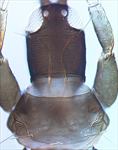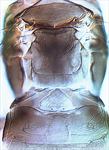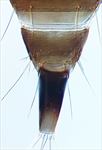
Head and pronotum

Antenna

Antennal segments III–VI

Metanotum, pelta and tergite II

Throacic sternites

Abdominal segments VIII–X
Both sexes fully winged. Body and legs dark brown; antennal segments III–VI yellow, VII extensively yellow, VIIII dark brown; fore wing pale, clavus weakly shaded; major body setae pale. Antennae 8-segmented; segment III with one sense cone, IV with 3 sense cones; sense cones short; VIII not constricted at base. Head longer than wide; vertex with transverse striae, but ocellar region without sculpture; maxillary stylets retracted to postocular setae, no more than one fifth of head width apart medially; post ocular setae with apices weakly expanded, shorter than dorsal eye length; mouth cone short. Pronotum almost smooth medially, with five pairs of capitate major setae, am and aa setae about half as long as pa and epim setae; epimeral sutures complete; prosternal basantra not developed, ferna present, mesopresternum boat-shaped. Fore tarsus without a tooth. Metanotum weakly reticulate medially, median setae small and acute. Fore wing parallel sided, with 13–18 duplicated cilia; three capitate sub-basal setae sub-equal in length. Tergite IX setae S1 pointed and shorter than tube, S2 slightly blunt at apex.
This Oriental species has been known in Florida for many years, but was not recognised in California until 2011. A detailed description was provided by Okajima (2006). Currently, there are almost 280 species listed in the genus Liothrips, although 30 of these are placed in two sub-genera known only from Asia. As a result, this is larger than either Thrips or Haplothrips, these three being the largest genera of Thysanoptera. However, in comparison to both Thrips and Haplothrips there are far greater problems in Liothrips in species recognition. A particularly high proportion of the described species are known from single samples, or even single individuals, resulting in little knowledge of variation within and between species, and thus the general assumption that most members of the genus are host-specific requires extensive testing. Stannard (1957) listed 32 species of Liothrips from North America, and subsequently (Stannard, 1968) included 14 of these in his keys to the Illinois fauna. Cott (1956) treated 11 species from California, two of which he placed in Rhynchothrips. Currently from this State there are 13 Liothrips species listed (Hoddle et al., 2004) of which several cannot at present be recognized.
Breeding on young leaves, and apparently specific to Cinnamomum camphora [Lauraceae].
Originally from the Oriental tropics, including Sri Lanka, Taiwan, and Japan, but introduced to Florida and California.
PHLAEOTHRIPIDAE, PHLAEOTHRIPINAE
Liothrips floridensis (Watson)
Cryptothrips floridensis Watson, 1913: 145
Cott HE (1956) Systematics of the suborder Tubulifera (Thysanoptera) in California. University of California, Berkeley, Publications in Entomology 13: 1–216.
Hoddle M, Mound LA & Nakahara S (2004) Thysanoptera recorded from California, USA: a checklist. Florida Entomologist 87: 317–323.
Okajima S (2006) The Suborder Tubulifera (Thysanoptera). The Insects of Japan 2: 1–720. The Entomological Society of Japan, Touka Shobo Co. Ltd., Fukuoka.
Stannard LJ (1957) The phylogeny and classification of the North American genera of the sub-order Tubulifera (Thysanoptera). Illinois Biological Monographs 25: 1–200.
Stannard LJ (1968) The Thrips, or Thysanoptera, of Illinois. Bulletin of the Illinois Natural History Survey 29: 213–552.